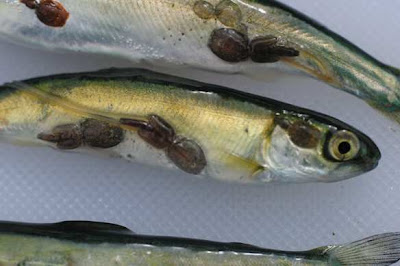Yes. At 5:30 in the video The narrator says the effect of that"infestation" are yet to be seen in the 2010 return. That return was the best return in 100 years. I suspect that video will be taken down for that hard fact which a poses the narrators beliefs. Interesting point bgm.
It is telling that these video's never show video of the sample as a whole it only hand picked samples that make the headlines such as the hand picked samples in the white bucket in this video.
It's all good then right? Those sea lice on the smolt were just a one off and there really is no problem with Sea Lice on Fish Farms is there? Why do they use SLICE?
Chemical Treatments: SLICE

Atlantic salmon with sea lice.
Salmon farms are breeding grounds for
sea lice due to the high densities of fish in relatively small net-cages. In an attempt to control chronic lice infestation, salmon farmers use pesticide treatments. Emamectin benzoate (marketed as SLICE®) is the preferred chemical for sea lice control in Canada. However, the use of this pesticide has long been opposed by scientists and environmental groups due to lack of thorough scientific research on its effects.
Up until June 2009 SLICE was only available to fish farmers through the Emergency Drug Release Program, which allows the use of non-approved drugs when recommended by veterinarians for emergency situations. In June 2009, Health Canada quietly approved the use of this chemical and when CAAR contacted Health Canada requesting approval criteria, we received the disturbing response that research was conducted by the manufacturer, is proprietary, and is not available to the public.
The previously required withdrawal period of 68 days between the last use of SLICE and harvest of the treated fish has disappeared with the approval. Given that SLICE has been shown to persist in the tissue of fish and the environment for weeks to months, this is a step backward for food and environmental safety.
Fisheries and Oceans Canada (DFO) and the Ministry of Environment are currently conducting a joint study on the biological effects of SLICE, but findings won’t be released until fall 2009 or later. The University of Victoria also has a similar study underway. As these critical studies are still pending, approval of this pesticide is totally inappropriate.
Emamectin benzoate belongs to a class of chemicals called avermectin which are poisons affecting nerve cells.1 Farmed salmon ingest SLICE as an additive to their feed. Upon digestion, the drug passes through the lining of the fish’s gut and into its tissues, where it is then absorbed by sea lice attached to the fish’s body. SLICE can begin to control sea lice numbers on fish in as little as a few days after treatment. Although SLICE contains emamectin benzoate (0.2%), an active ingredient in pesticides, it is classified as a drug because it is fed to the fish rather than applied externally.
SLICE is not a targeted treatment; it affects the skeletal build up of crustaceans—including prawns, crab, and shrimp, as well as sea lice. Also, because of its ability to accumulate in sediments, SLICE could become toxic to other marine life. Its frequent use on salmon farms could therefore jeopardize the livelihoods of coastal fishing communities reliant on wild species.
The label of the pesticide ‘Proclaim’, in which emamectin benzoate is the only active ingredient, clearly warns that:
“This pesticide is toxic to fish, birds, mammals, and aquatic invertebrates. Do not apply directly to water, or to areas where surface water is present, or to intertidal areas below the mean high water mark. Do not contaminate water when cleaning equipment or disposing of equipment wash water.” 2
The US Food and Drug Administration has listed emamectin benzoate as an unapproved drug that should not be used on fish destined for consumption in the US. However, according to Canadian government information, on average, this chemical is being used at least once during the production of every farmed salmon from British Columbia – with over 80% of this product going to the US market.
Since 2005, salmon farmers in BC have used an average of 7,240 kilograms of SLICE per year to treat lice-infested fish – showing a steady dependency on the drug.3
Meanwhile, reports from Chile, Norway and Canada’s east coast have indicated that sea lice are showing signs of resistance to treatments, including emamectin benzoate, likely due to frequent and heavy applications.
Signs of resistance have led to the testing of alternative pesticides. In July 2009, scientists, environmentalists and fishermen raised concerns about the testing of deltamethrin, marketed as Alphamax®, on a few of Cooke Aquaculture’s farms in New Brunswick. Deltamethrin is highly toxic to crustaceans and is administered via a chemical bath: the net-cages are surrounded by tarps, farmed fish soak in pesticide solution and then the tarps are opened and the chemical is released into the ecosystem.
Open net-cages perpetuate this chemical dependency and by design cannot prevent the transfer of parasites between farmed and wild fish.
Based on existing trials, closed containment systems address the sea lice problems that plague net-cage salmon farms by separating farmed and wild fish. This separation could potentially eliminate the need for toxic chemical treatments and any chemical release into the environment. Learn more about
closed system aquaculture.
References
1 Valles, S.M. and P.G. Koehler, Insecticides used in the urban environment: mode of action. 1997, University of Florida Institute of Food and Agricultural Sciences: Gainseville, FL p. 4
2 Novartis, Proclaim Insecticide. 1999, Novartis Crop Protection, Inc.: Greensboro, NC p. 7
3 BC Ministry of Environment



